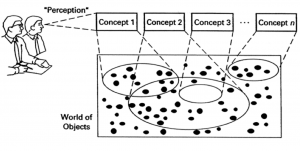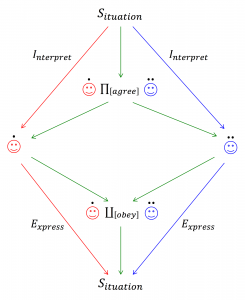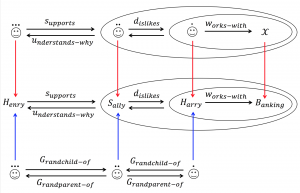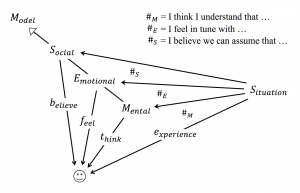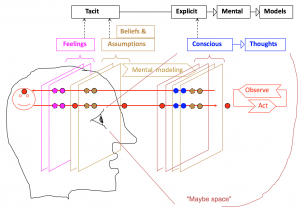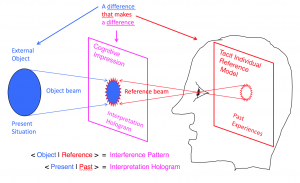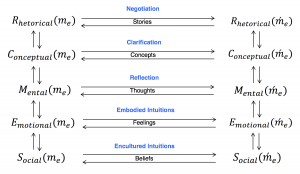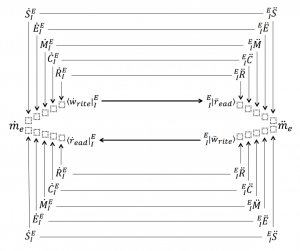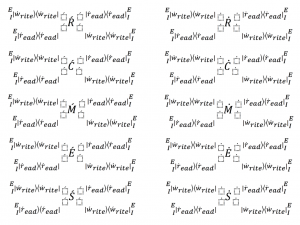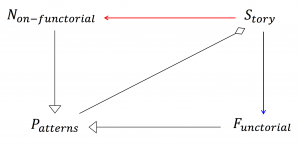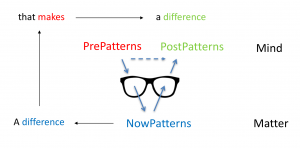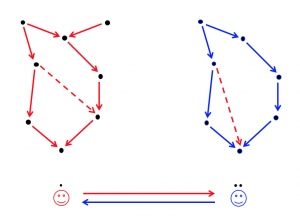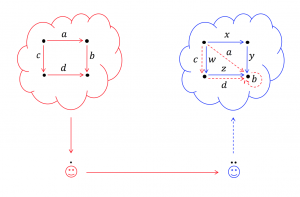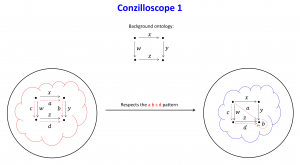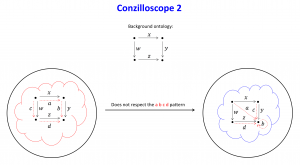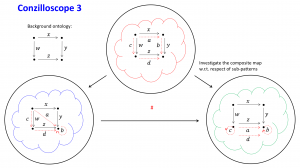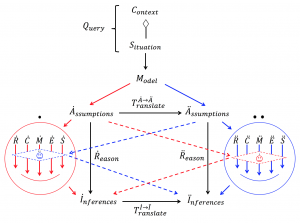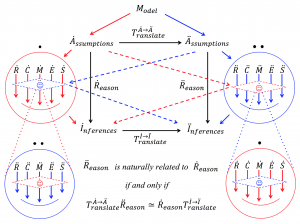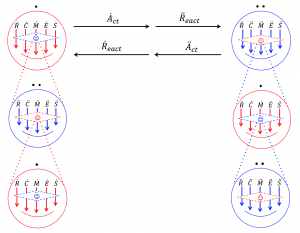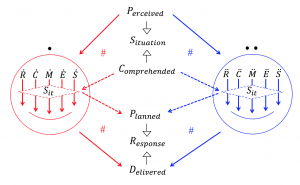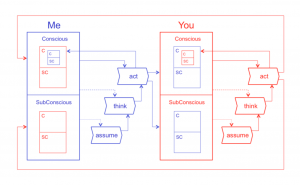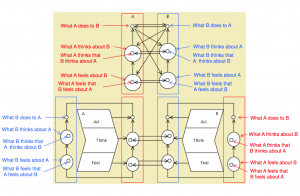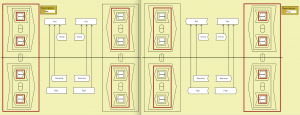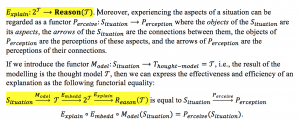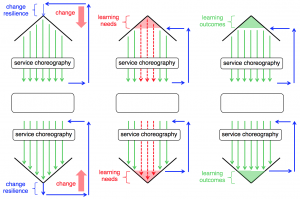for Communicative Quality Assurance
=================================
This is a sub-page of our page on The Human Category.
///////
Related KMR pages:
• From Opiniocracy to Visionocracy
• Modeling and Mapping
• Knowledge Negotiations
• Knowledge Manifolds
• Disagreement Management
• Collectigence
• Abductive thinking as as Pseudo-inverse
• Humanity Inc. – from corporation to cooperation
• Common Sense
• Provocative Modeling
• Systems Modeling
• Global Warming
///////
Other relevant sources of information:
• TEL-Map D1.1:
A Modeling Primary on Methods and Techniques for
Communicative Modeling and Disagreement Management
///////
Semantic Meta-networks for Communicative Quality Assurance
///
A digitally augmented library as part of a digitally mediated network of modeling stations could be of strategic importance by helping to shape knowledge modeling and knowledge manifolds into effective and efficient “weapons of mass construction” of both knowledge and work opportunities. In fact, these ‘weapons’ could become instrumental in helping us to adapt to our rapidly transforming knowledge society in a socially sustainable manner.
The applicability of the results presented here have to do with how to represent, orchestrate and choreograph the interplay between the downward (intra), in between (inter), and upward (supra) structural levels of collaborative knowledge construction. The aim is to support the dynamic unpacking of semantic information – within the context(s) of an ongoing knowledge negotiation (= learning conversation (Laurillard) between the agents involved and maximize the potential for unexpected and opportunistic collaborations between them. If the conditions are judged to be favorable, such collaborations can then be formalized in various supra-structures – often referred to as ‘start-ups’ in entrepreneurial jargon. A crucial requirement for effectively judging the favorability of a prospective common undertaking among a group of agents is to allow knowledge (= semantic information) to grow (= to be connected) from the bottom up.
The amount of information available today – as well as its disconnected nature – leads to the widespread experience of information fragmentation, while the promises of cross-institutional data collaboration and big data analytics lead to increasing demands for information interoperability.
This issue is made even more complex by the ongoing transformation – not to say paradigm shift – away from the traditional, document-centric way to describe (= annotate) information, towards more of a graph-centric way to provide such metadata (= information about the information). This approach, which is clearly visible in the LOD (Linked Open Data) movement, allows for a change-by-increment approach to evolution, a key success factor of object-oriented programming.
Through knowledge mapping, we will show how to create a mix between the cata-logical (top-down) teaching perspective and the ana-logical (bottom-up) student perspective. The fundamental research question is about how to represent and describe these opposing perspectives in ways that optimize the potential for positively synergistic mixtures between them.
This report discusses some key ingredients that we believe to be essential in achieving such seamlessly integratable and evolvable infrastructures, namely
(i) abstract service interfaces (ASIs),
(ii) categorical data patterns (CDPs),
(iii) thought models (Ologs),
(iv) knowledge algebra (KA).
The first three ingredients support evolvability of the interactions between the respective infrastructures through abstract service interfaces (ASIs) and dynamical development of patterns of descriptions/annotations (CDPs) and distributed reasoning (Ologs), while the fourth ingredient, (KA), enables the combinatorial overview that is necessary to avoid ad–hoc descriptional mappings and develop the foundation for systematic cross-institutional descriptions and reasoning as well as for scalable disagreement management.
///
///////
Interpreting objects through concepts:
///////
What we agree on and what we obey:
///////
Henry supports Sally:
///////
Multi-level commutativity:
///////
Mental modeling:
///////
Interpreting an Object through a Model:
///////
Overview of Human Communication:
///////
Explicitly and tacitly supported communication loop:
///////
2-agent conversational knowlecule:
///////
Functorial and non-functorial patterns:
///////
A difference that makes a difference:
///////
How a difference makes a difference:
///////
\, {\mathbb 2}^{P_{rePatterns}} \, \stackrel {N_{owPatterns}} {\longrightarrow} \, {\mathbb 2}^{P_{ostPatterns}} \, \, {\mathbb 2}^{P_{rePats}} \, \stackrel {N_{owPats}} {\longrightarrow} \, {\mathbb 2}^{P_{ostPats}} \,• Expansion of Time into a Laurent series of moments
[…]
///////
Communicating through thought-graphs:
///////
Mapping a thought-square 1:
///////
The Conzilloscope
///////
Two cognitive agents modeling a situation in Me^3 + You^3:
///////
Two cognitive agents modeling a situation 2:
///////
Two cognitive agents modeling a situation 3:
///////
Two cognitive agents modeling a situation 4:
///////
Conscious and Sub-Conscious Communication:
///////
Communication model for Human Atolls:
///////
Me^3 and You^3:
/////////////////////////////////////// Infrastructures for Cross-Institutional Reasoning, pp 175-184):
23. Modeling the development of knowledge and skills
In this section we will model the cognitive feedback loop (Naeve, 2011, 2013) of an agent/participator from the perspective of development of its knowledge and skills. In the models appearing here, knowledge is equated with theory (in the form of thought patterns or models), and skills are equated with practice (in the form of behavior patterns).
23.1. Trying to stay in the flow – modeling the cognitive feedback loop

Fig. 120 Understand as perceived – act as intended.
Figure 120 depicts a model of the basic cognitive feedback loop. An agent/participator experiences different aspects of a situation, thinks about them and tries to model them into thought patterns that can create an understanding (= explanation) of these aspects that are in agreement with (= are coherent with) how they are perceived by the agent.
In this model, the actions can be of two different types: reflective action, guided by the thought patterns and affective action, guided by affective patterns based on feelings. In reflective action, the agent makes use of the updated thought patterns to decide whether or not it wants to change some of the aspects it has reflected upon. If it does, the agent then acts to develop the appropriate skills, which are then expressed/manifested in the form of updated behavior patterns. The agent then applies these behavior patterns to the aspects it wants to change in the form of actions that aim to change them as the agent intends.
A thought pattern makes sense of an aspect if the pattern explains the aspect as it is perceived (= sensed) by the agent. A behavior pattern feels right with respect to an aspect if the pattern changes the aspect in accordance with the intention of the agent.
Figure 121 shows the same loop with a focus on a single aspect. It also introduces the # sign, a sign which means that the corresponding aspect triangles are commutative, i.e., that the idea explains the aspect as it is perceived, respectively that the application of the practice changes the aspect as intended.
As described in section 14.3 above, we can think of a thought pattern as a category and a reasoning or an explanation that conforms to this though pattern can be thought of as a functor
///////
Model as perceived – change as intended:
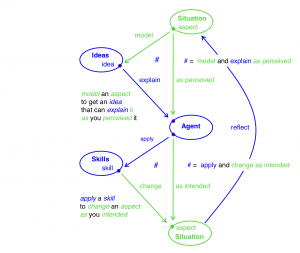
Fig. 121 Model to explain things as perceived, develop skills to influence things as intended
Figure 121 and Figure 122 depict a situation where there is no need for learning. At the “reactive” level, which corresponds to the ingoing arrows in the upper part of the figures, the explanations of all relevant aspects of the situation, are effective and efficient. They explain the aspects of the situation as they are perceived by the agent. At the “active” level, with outgoing arrows in the lower part of the figure, relevant skills are applied effectively and efficiently by the agent to change the relevant aspects of the situation as it intends.
# means “good enough”: No need to learn when every triangle commutes:
This flow-like state of affairs is modeled by the fact that all aspect triangles appearing in Figure 121 and Figure 122 are commutative, i.e., it does not matter which of the two possible routes that you traverse them by. This is the meaning of the # sign in the figures.
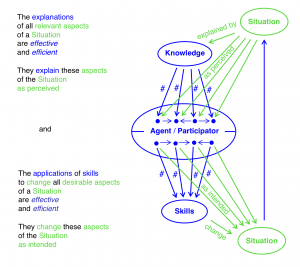
Fig. 122. The experience of being “in the flow”.
23.2. Breaking and restoring the flow
In Figure 123 the situation has changed so that the “reflection triangles” involving aspects a and b of the situation have become non-commutative (#), which means that aspects a and b are no longer explained by the present knowledge in the way that they are perceived. Hence there is a need for “better knowledge”, which is knowledge that can repair the broken explanations of a and b.
Moreover, since the “action triangles” involving aspects c and d of the situation have become non-commutative, these aspects are no longer influenced (= changed) by the agent in the way that it intends. Hence there is a need for developing better skills that can influence these aspects as intended.
Learning kicks in when some triangles don’t commute:
Better knowledge and better skills restore commutativity:
In Figure 124 the commutativity of the problematic aspect triangles has been restored by developing better knowledge and better skills.
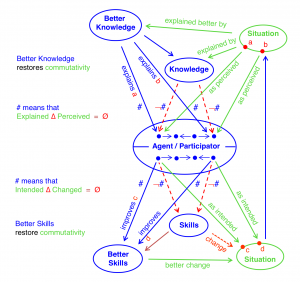
Fig. 124. Better knowledge and better skills restore the flow(s).
Among all the possible extensions (improvements) of the problematic knowledge the most effective and efficient ones are the ones that can be regarded as minimal. They correspond to the minimal principle of scientific causality formulated by Isaac Newton in his Principia (Newton, 1687): We shall not assume more causes for the natural phenomena than what is necessary in order to explain their appearances.
It is interesting to observe that such a minimal knowledge extension behaves as a limit (or pullback) of the old knowledge and its corresponding explanations, and the new knowledge with its new explanations, because any other knowledge extension (involving more causes) with the power to explain the situation can be uniquely mapped to a minimal knowledge extension by simply ignoring the superfluous causes and explanations.
23.3. The limit laws of intra-community reflection and action
In this section we will model the inter-reflection and inter-action of several cognitive systems. Each cognitive system could consist of a single (individual) agent, or of a group of agents (here called a community) that act as a cognitive unit.
Any reflective situation that “makes sense” to a cognitive system must be coherent with its tacit mental models (beliefs and assumptions). Hence, these tacit mental models function as the limit of the thought patterns of the cognitive system. Dually, any active situation that “feels right” to a cognitive system must be coherent with its ingrained behavior. Hence, this ingrained behavior functions as the colimit of the behavior patterns of the cognitive system. This situation is depicted in Figure 125.
///////
Mental models – Ingrained behavior:
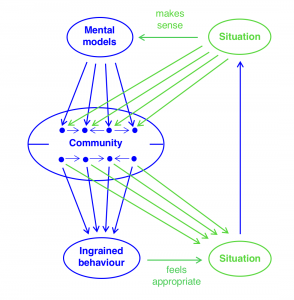
Fig. 125 Tacit mental models “make sense” and tacit ingrained behavior “feels appropriate” to a community
Hence we can formulate the following limit laws of intra-community reflection and action:
• The Situations that have unquestioned Community Relevance are precisely the Situations whose Reflections factor uniquely through the Community’s Mental Models. These are the Situations that “make sense” within the Community.
• The Situations that have unquestioned Community Co-relevance are precisely the Situations whose Actions factor uniquely through the Community’s Ingrained Behavior. These are the Situations that “feel appropriate” within the Community.
23.4. Modeling communi(ty)cation = inter-community reflection and action
When constructing an interoperability map between two communities, the pattern described above repeats itself on a different level. In order to arrive at a useful typology of inter-reflection and inter-action between stakeholder communities, we will consider three different levels of inter-community mental models and ingrained behavior: shared, represented, and unrepresented. In set-theoretic terms, ‘shared’ corresponds to the intersection of the mental models or the ingrained behavior of the involved communities, while ‘represented’ corresponds to the union of their mental models or ingrained behavior. Finally, ‘unrepresented’ corresponds to whatever is unexpressable, unthinkable, or unfeelable (see section Fel! Det går inte att hitta någon referenskälla.) – either in terms of mental models or ingrained behavior.
Figure 126 depicts a situation in which two agents (individuals or groups) are inter-related in some way. The inter-relation between the agents consists of an inter-reflection part and an inter-action part. Here we are introducing the SECI notation (section Fel! Det går inte att hitta någon referenskälla.) with a slight modification: S now stands for Signification and C stands for Collaboration.
Inter-relation and inter-action:
As before, the agents of Figure 126 can be individuals or groups of individuals, such as communities, acting as a unit. In the following discussion, we will think of each agent as representing a community of practice or interest.
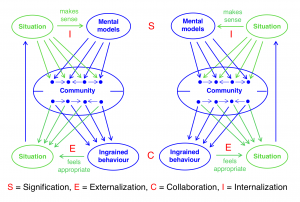
Fig. 126. Inter-relation consisting of Inter-action and Inter-reflection between two Agents
Shared mental models – shared ingrained behavior:
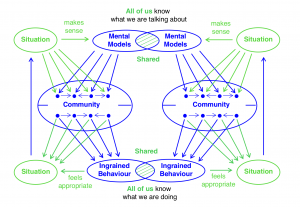
Fig. 127. Shared/Shared inter-relation mode: shared mental models and shared ingrained behavior.
Figure 127 depicts a situation where two communities are ‘inter-relating’ with each other in the shared/shared (= intersection/intersection) mode with respect to their mental models respectively their ingrained behavior, then the thoughts make sense and the actions feel appropriate. As stated in the figure, “All of us know what we are talking about” and “all of us know what we are doing.”
A good example of a shared/shared type of inter-relation mode would be a family-type of soccer game audience from different communities that are drawn together by the love of an activity (soccer) which they all agree “makes perfect sense” to watch and contemplate, and which they all agree “feels quite appropriate” to engage in.
Union and intersection of mental models and ingrained behavior
However, when soccer hooligans enter the arena, they represent a community with rather different mental models and ingrained behavior with respect to a soccer game. This will change the resulting modes of community inter-relatedness on the spectator tribune in a way that is described below.
When communities inter-relate in a represented/shared (= union/intersection) mode, the participants will be somewhat tense (= wary) since mental models that are not shared will be used in the contemplation of some situations. When such situations arise, the participants that do not share the corresponding mental models will experience a need to raise questions of protocol. A corresponding (dual) form of tenseness (wariness) occurs when communities inter-relate in the shared/represented (= intersection/union) mode.
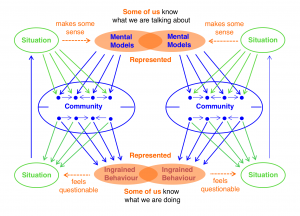
Fig. 128. Represented/Represented inter-relation mode: union of mental models and union of ingrained behavior.
The hooligans entering the soccer area (described above) will change the mode of community-inter-relatedness from shared/shared to represented/represented (Figure 128). In this case, only some (and not all) of the spectators will understand why fireworks have to be thrown onto the arena and opposing fans have to be beaten up. The family-type community members will become tense when such situations occur and even leave the arena before their children get hurt.
Unrepresented interrelation modes
When communities inter-relate in the unrepresented/shared mode, they share the ingrained behaviour but do so in a totally un-reflective and unaware way since they do not share any mental models. This means that the communities involved are highly focused on “getting things done in the obvious way” without reflecting on why they should be done that way. A typical example could be soldiers from different communities (e.g., academic, and blue-collar) that went to Vietnam (or go to Iraq and Afghanistan) to “get the job done” without reflecting on what the job is about. “All of us know what we are doing but none of us know why we are doing it.” This is a situation that will tend to create a lot of un-expressable fear, often resulting in post-traumatic stress symptoms – since there are no common mental grounds for discussing what is happening.
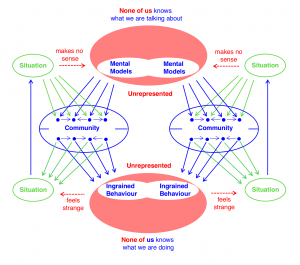
Fig. 129. Unrepresented/Unrepresented inter-relation mode.
Dually, when communities inter-relate in the shared/unrepresented mode, the reasons make sense but nothing gets done. Far too many typical examples can be observed in politics, where committees from different communities frequently create endless policy documents, without being able to implement any practical action based on them.
The remaining three possibilities of community inter-relatedness are all characterized by low inter-coherency of both reflection and action. In the represented/unrepresented mode of inter-relatedness, there is some amount of reflection but no common actions can occur (since no participating community knows what to do about the corresponding situation. In the dual mode of unrepresented/represented community inter-relatedness, there is some amount of action (driven by the ingrained behaviour of some of the participators) but no reflection at all. Finally, in the unrepresented/unrepresented community inter-relatedness mode (Figure 129) there is no inter-community action or reflection going on at all. “None of us knows what we are doing and none of us knows what we are talking about.”
///////
24. Learning as service (re)orchestration and (re)choreography
An agent that is operating in an external environment can be thought of as being involved in orchestrating and choreographing different sets of “services” or “affordances / opportunities” provided by the agent’s environment and co-workers. In fact, we are so used to this behaviour that we ordinarily do not reflect on it. However, even when we perform the simplest operations, such as opening a door or sending off a message – as well as when we are performing more complicated operations, such as driving a car or operating a modern coffee machine – we are making use of the basic principles of service orchestration and service choreography as described e.g., by Lastra and Delamer (2006).
Service orchestration deals with figuring out which services that are needed in order to perform the task at hand, while service choreography deals with how these services should be connected in order for them to interoperate as effectively and efficiently as possible and achieve the desired overall result. Hence, in this model, service choreography presupposes service orchestration, and below we will use the term “service choreography” to cover them both if no further distinction is needed.
Figure 130 shows the active and reactive cognitive feedback loops of an agent that is involved in choreographing a bundle of services. In the right part of the figure, the agent “is on top of things” with respect to the reactive loop and “under the bottom of things” with respect to the active loop. Change is represented as a force that is lowering the top and raising the bottom of these loops – in terms of the agent’s ability to keep the flow going. As displayed in the right part of Figure 130, the agent even possesses a certain resilience to change.
If we think of the ”service-arrows” as a kind of water-tubes, we can say that change makes the agent “break out of the flow” by losing its ability to pump the water onto its entire “mental roof” and/or its ability to collect the water that drains from its entire “action floor”. In either case, some of the flows are broken and the corresponding parts of the choreography are affected. In the middle part of Figure 130 this has happened to the processes that are operating within the red triangles. No water can flow through the tubes that are red (and dashed) in Figure 130.
The process of change, by breaking such flows, confronts the agent with learning needs of various kinds. In the left part of Figure 130 these learning needs have been properly addressed by “lowering the water intake” of the problematic tubes enough” and/or “raising the water outlet of the problematic tubes enough” in order to restore the corresponding parts of the flow. This improvement of knowledge and skills can be thought of as an increase of the agent’s agility. Increasing ability increases agility is the pattern at work here.
24.1. User understanding and misunderstanding
Whenever we engage with a service we need reactive (= mental) models that help us comprehend the choreography of its parts as well as the active (physical) skills that help us carry them out in accordance with this comprehension.
This situation is depicted in Figure 131 where two users, User1 and User2 , are engaging with a Service. User1 completely comprehends the choreography of the Service and therefore uses it correctly (= as intended), but User2 misunderstands part of the choreography and therefore uses the corresponding subservices incorrectly (i.e., misuses them), which leads to the broken flows indicated by the presence of the red parts of Figure 131.
///////
